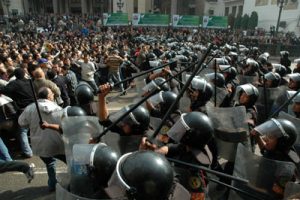Tears and Joy of Tahrir!
Opened just two months after the start of protests, Tahrir! embodies the texture as well as the spirit of a revolution that is still ongoing.
It was mid January, 2011. Most of Europe and Northeast America was buried in snow and suffering from a chill factor below zero. The earth in Japan was about to crack and cause a tsunami that would take the lives of thousands and turn homes and villages into matchsticks.
Cairo was ablaze with revolution. In the center of the city, swelled with a million Egyptians, there was a cloud of hope. But it also rained live bullets, rubber bullets and canisters of tear gas. There were martyrs after intrusions by murderers. Some of the people retaliated with Molotov cocktails but most expressed an unarmed defiance. Many were swathed in bloodied bandages. When the call to prayer was heard, thousands lined up to pray and invoke the Name of Allah. They bowed with their heads to the ground, resting on newspapers whose headlines declared revolution. Theirs was a prayer for peace and freedom.
This is Tahrir Square, the epicenter of Egypt’s January 25 revolution. It is also Tahrir!, an exhibition at The Photographic Gallery at the American University in Cairo. Opened just two months after the start of protests, Tahrir! embodies the texture as well as the spirit of a revolution that is still ongoing. It is a multimedia installation that presents the work of 20 photographers but includes Egyptian flags, protest signs, stencils, security barricades, pavement stones hurled at police and other artifacts from the heart of this historical event. At the exhibition that opened on April 3, hundreds of visitors wandered among the stones, plastic tents, blankets, empty teacups and the walls of graffiti. BBC news bulletins were projected onto a wall and mingled with the sweet voice of an Egyptian woman named Layla singing revolutionary songs. Many sang with her. For a moment they were in Tahrir.
The photographs capture the grief, pain, suffering and joy of the people. Roger Anis caught the spirit of the protesters as they shared food, laughter and expectations. Fadi Ezzat memorably recorded the brutality of the helmeted police beating back the advancing unarmed people. A photograph by Thomas Hartwell shows the magnitude of the masses in Tahrir Square, which had more people than the World Cup. Amr Abdullah immortalized the emotional moment when Christians formed a human ring around praying Muslims to protect them from the onslaught of security police.
Art is the purest language for communication. An exhibit of this kind, an installation, a replica of an ongoing event, allows for a reflection of events for those who witnessed them first-hand, and provides a space of experience for those who did not get to Tahrir Square. This moment of Egyptian istory that woke the entire Middle East and willchange the balance of power in the world should not be forgotten.
At the Tahrir! opening, it began to rain, just as it had in the square at the height of the protests. “We thought our children would not amount to much,” said one man, “and now we are grateful to them, they are a generation that did what we could not.”
The rain continued. A gallery assistant locked the glass doors and left the exhibit to the solitude of the night. I wrapped a scarf around my head and walked into the rain. Was it rain or the tears of the martyrs of Tahrir? I remembered the words of a Sufi sheikh.
“If you don’t learn from the lessons of others, you become lessons for others.”
Shems Friedlander is a professor of practice in the Journalism and Mass Communication department at the American University in Cairo and director of The Photographic Gallery at AUC. He is the director of the forthcoming documentary film, Faisal: Legacy of a King. His other documentary films include, Rumi:The Wings of Love and The Circles of Remembrance. He is the publisher and editor of the journal Zawiyah, Occasional Papers on Sufism.
Tahrir! The Photographic Gallery, Abdul Jameel Hall, Plaza Level, Sunday-Thursday 10 a.m.-5 p.m. The exhibit is extended until May 15. Photographers: Amr Abdallah, Ahmed Abdel Latif, Nabeela Akhtar, Roger Anis, Omair Barkatulla, Fady Ezzat, Ashraf Foda, Ramy Georgy, Thomas Hartwell, Ahmed Hayman, Iman Helal, Mohammed Helal, Magdy Ibrahim, Mahmud Khalid, Heba Khalifa, Mohamed El Maymouny, Gehan Nasr, Randa Shaath, Lobna Tarek, Doha Al Zohairy.
Photo credit:
Fady Ezzat
Ahmed Hayman
Heba Khalifa






